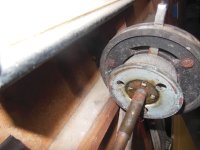jfarris
Jedi Trainee
Offline
Steve, thanks for re-posting the article about how to re-assemble the control head. Because I don't have the little pins that cancel the signals, it was a bit easier to put back together.
However, I can't get the wires back down and out the lower end of the stator tube when they are wrapped as a bundle. I thought I would ask before I unwrapped them. I took the bullet connectors off and have some new wrap to cover them after they exit the steering box in case I have to unwrap them.
I used a small taped loop for each wire group using some 14 gauge wire and also tried with some super fine safety wire to pull it from the bottom. I do have some shrink tubing over the lower end of the new wire bundle to keep the wrap in place. That may be catching on something near the bottom of the stator tube.
Thanks for all the help!!!
However, I can't get the wires back down and out the lower end of the stator tube when they are wrapped as a bundle. I thought I would ask before I unwrapped them. I took the bullet connectors off and have some new wrap to cover them after they exit the steering box in case I have to unwrap them.
I used a small taped loop for each wire group using some 14 gauge wire and also tried with some super fine safety wire to pull it from the bottom. I do have some shrink tubing over the lower end of the new wire bundle to keep the wrap in place. That may be catching on something near the bottom of the stator tube.
Thanks for all the help!!!

 Hi Guest!
Hi Guest!

 smilie in place of the real @
smilie in place of the real @
 Pretty Please - add it to our Events forum(s) and add to the calendar! >>
Pretty Please - add it to our Events forum(s) and add to the calendar! >> 

